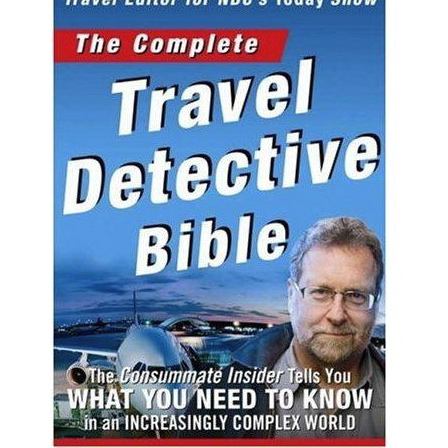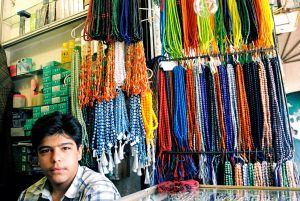
In my estimation, fear is the worst four letter word starting with “F.” And when it comes to travel, “fear” is a serial journey killer.
It keeps us from exploring the world, from discovering new places and experiences.
Don’t think you can — or should travel to certain countries and regions? You will be pleasantly surprised, perhaps, to learn that you CAN get there from here, and in almost all cases, you can get there safely, you can immerse yourself in that culture, have a great experience, and make some new friends along the way.
And perhaps the overriding reason why you can — and perhaps should — get there from here: the power of travel and tourism. It is the largest industry in the world, employs the most number of people, and is singularly responsible for the GDP of dozens of countries.
In recent years, within the most difficult countries, the hardest dictatorships, their rulers have had to come to grips with an economic reality: forgetting the obvious benefits of building bridges and forging peace, travel and tourism was the one — and in many cases the only — salvation for their economy.
And slowly, and without hesitation, the doors opened. And those doors have been kept open by the flood of foreign exchange — these countries have been fueled by the currency provided by travel and tourism.
Here is just a small sampling of countries that are available to you:
Afghanistan
 Despite the difficult years since Sept. 11, there no current restrictions on travel to Afghanistan — you can book a trip through a tour group, or call the consulate to apply for a tourist visa. After Kabul International Airport reopened, air travel to Afghanistan is the most convenient method of getting into the country. Airlines that fly into Afghanistan include: KamAir, Pakistan International Airways, Indian Airlines, Air Arabia and Qatar Airways
Despite the difficult years since Sept. 11, there no current restrictions on travel to Afghanistan — you can book a trip through a tour group, or call the consulate to apply for a tourist visa. After Kabul International Airport reopened, air travel to Afghanistan is the most convenient method of getting into the country. Airlines that fly into Afghanistan include: KamAir, Pakistan International Airways, Indian Airlines, Air Arabia and Qatar Airways
As with any country there are some regions safer than others. Most of the violence is localized south of Kabul, but it’s relatively safe in Kabul and in the southwest and western regions. In the south, travel is difficult unless you have a lot of support on the ground, which is not easily available.
After the U.S. invasion, it’s estimated that about 1/3 of all public buildings and 40 percent of housing were totally destroyed. The remaining tourist attractions include The Gardens of Babur (the tomb of the first emperor), and the Afghanistan National Museum that reopened in 2004. You can also travel outside of Kabul to explore the country’s mountainous regions and the Band-l-Amir lake region.
Hotels are also starting to make their mark in the redeveloping city of Kabul. In April 2007, the Government of Afghanistan and US-based General Systems International execute a 99-year lease agreement for the construction of a 209-room, five-star Marriott Hotel in Kabul. The 5-star, 177-room Kabul Serena Hotel opened its doors back in 2005.
Distant Horizons offers a 3-week tour called “Crossing the Khyber Pass: Afghanistan and Pakistan.” Begin by exploring the capital city of Kabul, which includes Kabul Museum and the Babur’s Garden. Fly west to see Musalla complex, and onto Mazar-e Sharif, Afghanistan’s second largest city. Then travel to Balkh, considered a “cradle of religion,” and drive through green valleys to Bamiyan, once the center of the Kushan Empire. The tour will take you through the Khyber Pass into Pakistan’s North-West Frontier Province, then north to Swat where Buddhism flourished for centuries. $7,490. 800-333-1240, www.distant-horizons.com
Afghan Logistics & Tours provides both packaged and customized tours. Visitors are transported all-new 4-wheel-drive vehicles, and stay in local guest houses. The packaged tours run for 6, 10 and 15 days, and can include a visit to Kabul, the 6-hectacre Babur Gardens, Television Mountain and Chicken Street, catch a Friday night “buzkashi” game (aka the “Goat Grabbing contest”), the Shomali Plain north of Kabul, the Shibar Pass, Bamiyan and the famous Buddhas, the lakes of Band-l-Amir, Mazar-l-Sharif, Balkh (a center of Buddhism), Ai Hafnium (the only Greek city in Central Asia, most likely founded by Alexander the Great), the Slang Tunnel and the beautiful Punisher Valley. Tour rates vary due to the instability of fuel prices, but an individual traveler can expect to pay about $500 a day, and small groups of 2-3 people can spend $150-$200. www.afghanlogisticstours.com
Hinterland Travel has several tours to Afghanistan, including a 21-day Road Tour that drives through Pakistan, Afghanistan and Iran. A 24-day tour of Central and Northern Afghanistan start in Islamabad, takes you over Khyber Pass to Allahabad and to Kabul for a city excursion. You’ll spend about 4 days driving through the Lakes of Bandi-l-Mir Chak Charan, Minaret of Djam, Chist and Obeh to Herat. Trips range from $3,458 to $3,756. +44 (0)1883 743584, www.hinterlandtravel.com
Iraq
Daily bombings, sectarian violence, rampant corruption, spotty services, frequent kidnappings, and rising anti-Western sentiment make Iraq one of the least hospitable countries in the world at the moment. But, apparently, it all depends on where you go.
There’s at least one part of Iraq that comprises a notable exception to the don’t-go-to-Iraq rule. The northern third of the country, popularly called “Kurdistan,” is comparatively peaceful. Bombings and violence are relatively rare in cities like Sulaimany and Erbil, which are controlled by an autonomous Kurdish government. Erbil, in fact, receives regularly scheduled flights from a number of Middle Eastern and European cities.
And, here’s the fun part: check out the website www.theotheriraq.com to see its tourism commercials, encouraging Americans to visit. In at least one commercial, the Iraqis claim that one of the reasons to visit the region is that there are “less than 200” coalition troops based there. Now, that’s a reason.
Austrian Airlines became the first European airline to fly to Iraq, going to Erbil (or “Arbil” or even “Urbil”) in 2006. Erbil is one of Iraq’s largest cities (it’s the largest in Kurdistan) and provides safe access to Mosul and Sulaymaniya. Austrian Airlines now operates four times weekly, using Airbus 319 aircraft. 800-843-0002, www.austrianair.com.
Hinterland Travel operates tours in North Iraq Kurdistan year-round. Generally, everything but flights to and from the country is included, such as insurance and visas. Their tours have been put on hold now for some time as they cannot guarantee travel around Iraq and access to the sites; however, they are optimistic that they will resume tours in 2007. In the meantime they will operate their exploratory tour, a North Iraq Kurdistan and Kurdistan Iran tour beginning in Turkey. hinterland@btconnect.com, www.hinterlandtravel.com
The Kurdistan Development Corporation offers travel packages to press and business travelers. Additionally, they provide services on airline travel, security advice, visa requirements and activities in the region. www.kurdistancorporation.com
Iran
 While President Bush may have assigned it to the “Axis of Evil” fraternity, Iranian-American relations have been notoriously difficult since the Iranian Revolution in 1979.
While President Bush may have assigned it to the “Axis of Evil” fraternity, Iranian-American relations have been notoriously difficult since the Iranian Revolution in 1979.
Despite this, a few Americans do travel to Iran each year, and most find the country to be surprisingly safe. That reputation for safety has been dented by the recent disappearance of an American businessman from Kish Island, a popular spot off Iran’s coast.
Still, most tourists, even American ones, report feeling fairly welcome in Iran. Unlike many other “tough travel” destinations, Iran has not suffered from internal fighting in recent years, and its travel infrastructure is consequently in better shape.
The country also boasts a number of impressive UNESCO sites, including the ancient city of Persepolis, the intricate Dome of Soltaniyah, and Naqsh-I Jahan Square, as well as various monuments and art dating back hundreds and thousands of years to the Persian Empire.
Once again, the State Department urges Americans “to carefully consider the risks of traveling to Iran.” And since the US doesn’t have formal relations with Iran, there is no embassy or consulate in the country to help in case of trouble. Travelers should apply 2-3 months ahead to the Embassy of the Islamic Republic of Iran for visas. For more information, visit www.IranTravelingCenter.com/visa_iran.htm
Jerry Dekker, a professor of Humanities at the New College of California, San Francisco, offers unique study tours to Iran that are open to non-students who are interested in participating. Dekker, who lived in Iran for 10 years, speaks Farsi and has high-level contacts within the country, and operates what are perhaps the most unique and immersive tours in Iran. A 2-week tour called the “Silk Tour of Iran” visits the centers of Shiraz and Isfahan, as well as pilgrimage sites such as desert town of Yazd and the holy city of Qom. $2,500. Contact Professor Dekker at 415 67-6199 or www.irantraveler.net.
Geographic Expeditions has been traveling to Iran since 1993, and continues to include Iran into its ongoing itineraries. A 22-day “Treasures of Persia” tour begins in Tehran, and travels southwest to Hamadan and into the bazaar city of Tabriz. You’ll fly across northern Iran to Mashhad deep into the interior into the desert region of Yazd. Rates start at $5,425. 800-777-8183, www.geoex.com
Iran Doostan Tours is an Iranian-based travel company that offers adventure and custom tours specializing in interests such as skiing, trekking, camel riding, desert safaris, and hiking and diving. A tour of “Iran the Ancient” tours through Shiraz, into the Narenjestan Gardens, visits to various tombs and mosques throughout the countryside, and city tours of Isfahan and Tehran. Info@idt.ir, www.irandoostan.com
Liberia
 Not everyone realizes that Liberia is the only country in Africa that was once an American colony. In 1821, the first ship of free African Americans landed in Liberia. But two brutal, devastating civil wars (1989-1996 and 1999-2003) have nearly obliterated whatever progress Liberia had made since them. And as you can imagine, not a lot of tourists have been stopping in, either.
Not everyone realizes that Liberia is the only country in Africa that was once an American colony. In 1821, the first ship of free African Americans landed in Liberia. But two brutal, devastating civil wars (1989-1996 and 1999-2003) have nearly obliterated whatever progress Liberia had made since them. And as you can imagine, not a lot of tourists have been stopping in, either.
Today, Liberia’s President is a Harvard-educated, democratically-elected, former director of African Development for the UN named Ellen Johnson-Sirleaf. Africa’s first elected female head of state, Ms. Johnson-Sirleaf is beginning to make tangible progress in the efforts to rebuild Liberia despite having only been in office since January 2006. Refugee camps in neighboring nations are beginning to empty as Liberians return home. Relatively clean running water has been restored to over a third of Monrovia, and the first post-civil-war electric streetlights in the capital were turned on in July 2006.
Liberia still has enormous problems, though, and its tourism infrastructure was essentially shattered. Outside Monrovia, there are essentially no hotels or infrastructure approaching Western standards. In Monrovia, a few hotels like the Mamba Point Hotel and the Royal Hotel (with the city’s only sushi restaurant—the Living Room) are suitable for Western tourists. Just don’t expect luxury—and be thankful if the generators can give you electricity to power the air conditioner.
Because the tourism infrastructure is in such bad shape, most visitors to Liberia are volunteers assisting with the recovery efforts. A vast array of NGOs and volunteer programs have been welcomed into the country by President Johnson-Sirleaf.
UN Volunteers has created several opportunities for volunteers to travel to Liberia, including inviting professionals to teach at the University of Liberia, bringing together more than 1,000 UN volunteers and locals to a clean up campaign in the city of Zwedru, and raising awareness of domestic violence. +49-228-815 2000, www.unv.org
Mercy Ships is an organization that recently docked its ship “Africa Mercy,” the world’s largest charity hospital ship, in Monrovia. After serving more than 275 ports Anastasis was retired, and the ship’s surgical and health care projects are now being carried out by the Africa Mercy, with more than 400-member crew of medical and development volunteers. The ship is expected to perform more than 7,000 operations a year, including cataract removal, cleft lip and palate reconstruction and orthopedics. 800-772-SHIP, www.mercyships.com
Visions in Action is a grassroots organization that has traveled to Liberia to run education and training programs, assists 2,000 farmers in 40 communities to develop rice production, and produces a weekly radio show designed to inform the public of the efforts of humanitarian and development organizations. 202-625-7402, www.visionsinaction.org
North Korea
They don’t call North Korea the Hermit Kingdom for nothing. This tightly-controlled Communist country has largely been closed off to the rest of the world, and anti-American propaganda abounds. But don’t let the rhetoric scare you. The North Korean economy is in shambles, and pressures within the country are mounting to open the door slowly to travel and tourism. On five occasions so far, North Korea has extended an invitation to travelers with U.S. visas to enter the country for a very limited period of time, through a very select group of tour groups that have already established relationships with country officials.
In 2007, U.S. citizens North Korea opened its border to travelers in honor of its annual Arirang Festival (aka the Grand Mass Gymnastics and Artistic Performance, or the Mass Games) in Pyongyang. Although invitations were offered to Americans 1995, 2002 and 2005, the invitations came so close to the allotted window, most travelers couldn’t go. In 2006, organized tour groups did book tours to North Korea, but the Arirang Festival was cancelled due to flooding that killed more than 150 people.
It takes about 4 hours from Seoul to get into North Korea. To travel to North Korea, tourists will first need to visit Beijing to obtain the necessary visa—a procedure which rarely takes more than a day.
Keep in mind, that like a lot of tough travel, it won’t be a very relaxing, or cheap, trip. You can pretty much forget about shopping or exciting nightlife. And at about $500 a day, amenities like clean water, medicine and even electricity are often in short supply.
Visitors are expected to abide by all local customs and laws, which include bowing to the statue of Kim Il Sung in Pyongyang. Interaction with the locals will be limited, at best. This is one of the most tightly controlled societies in the world, so you won’t be mingling freely with the masses—in fact, you’ll get severe warnings before your trip (you start out in Beijing) about talking to locals. Just don’t do it.
In addition, all tour operators work very closely with the North Korean government, so each itinerary will be strictly adhered to. Every group will have two English-speaking tour guides, partly to watch you, and partly to watch each other. Thus, a trip to North Korea is – quite literally – at the top of my list for … people WATCHING!
Asia Pacific sponsored a 12-day trip in 2006 that was $4,199 per person, including airfare. In 2007, it led tours to North Korea during two separate windows, between April 15 and May 15, and between August 15 and October 15 timed with the Arirang Festival 800-262-6420, www.northkorea1on1.com
Poe Travel works with a Beijing-based tour company, and arranged a very quick tour from April 28 to May 1 for the Arirang Festival. There are plans to return to North Korea upon invitation next year, as well as tours to other “tough travel” countries.
501-376-4171, www.poetravel.com
San Francisco’s Geographic Expeditions arranges trips in conjunction with British tour company Koryo Tours, traveling to both North and South Korea. The 10-day trip ran started at $6,595.415-922-0448, www.geoex.com, www.koryogroup.com
Can’t wait to read more? Click here to purchase your copy of The Complete Travel Detective Bible.
Happy traveling!
Read even more tips from Peter’s latest book.
Find more Travel Book Spotlights.
Learn more about the debut of Peter’s book.
Get more information on Peter’s book tour.
And remember, Peter’s book is available wherever books are sold, and only from Amazon (see left) and BarnesandNoble.com.
For more “tough travel” trips, check out Really Tough Reality Tours.
For more on North Korea, look at Inside North Korea… The Real Life 1984 and Autumn in… North Korea?












